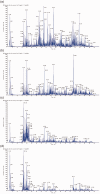Screening of Sceptridium ternatum for antitussive and antiasthmatic activity and associated mechanisms
- PMID: 29251256
- PMCID: PMC5805222
- DOI: 10.1177/0300060517722876
Screening of Sceptridium ternatum for antitussive and antiasthmatic activity and associated mechanisms
Abstract
Objectives Sceptridium ternatum is an expectorant in traditional Chinese medicine and is prescribed for the treatment of asthma. The study aim was to screen Sceptridium ternatum for ingredients with antitussive and antiasthmatic effects and to study their associated mechanisms. Methods Cough in mice was induced using ammonia. Cough latency and the number of coughs within 3 minutes were determined. Airway responsiveness was assessed using ovalbumin as a sensitizer and characteristic asthma indicators were measured. Results Chloroform and ethyl acetate extracts significantly reduced the number of coughs within 3 minutes, tidal volume, and the percentage of eosinophilic granulocytes, lymphocytes and neutrophils. All extracts decreased airway responsiveness in asthmatic mice compared with the untreated group. Petroleum ether, chloroform and n-butanol extracts lowered the Penh values of asthmatic mice. Petroleum ether and ethyl acetate extracts greatly reduced interleukin-4 expression and the interleukin-4/interferon gamma ratio. Compared with the model group, all extracts reduced mRNA expression of the cysteinyl leukotriene receptor-1 (CysLT1). Conclusions Chloroform extract and ethyl acetate extract displayed obvious antitussive effects and reduced airway inflammation. Thus, these two extracts contain the effective ingredients of Sceptridium ternatum. The active mechanism was ascribed to inhibition of mRNA expression of the CysLT1 receptor in mice with bronchial asthma.
Keywords: Sceptridium ternatum; acting mechanism; antiasthmatic; antitussive; asthma; effective ingredients.
Figures












Similar articles
-
Sceptridium ternatum extract exerts antiasthmatic effects by regulating Th1/Th2 balance and the expression levels of leukotriene receptors in a mouse asthma model.J Ethnopharmacol. 2013 Oct 7;149(3):701-6. doi: 10.1016/j.jep.2013.07.032. Epub 2013 Aug 9. J Ethnopharmacol. 2013. PMID: 23933317
-
[Experimental studies on antitussive, expectorant and antiasthmatic effects of extract from Citrus grandis var. tomentosa].Zhongguo Zhong Yao Za Zhi. 2006 Aug;31(16):1350-2. Zhongguo Zhong Yao Za Zhi. 2006. PMID: 17061559 Chinese.
-
Antitussive, expectorant and anti-inflammatory activities of different extracts from Exocarpium Citri grandis.J Ethnopharmacol. 2014 Oct 28;156:97-101. doi: 10.1016/j.jep.2014.08.030. Epub 2014 Aug 30. J Ethnopharmacol. 2014. PMID: 25178947
-
Cough, asthma, and cysteinyl-leukotrienes.Pulm Pharmacol Ther. 2013 Oct;26(5):514-9. doi: 10.1016/j.pupt.2013.06.003. Epub 2013 Jun 15. Pulm Pharmacol Ther. 2013. PMID: 23774534 Review.
-
Comparative Antitussive Effects of Medicinal Plants and Their Constituents.Altern Ther Health Med. 2018 Jul;24(4):36-49. Altern Ther Health Med. 2018. PMID: 29332022 Review.
Cited by
-
Spectrum-Effect Relationship-Based Strategy Combined with Molecular Docking to Explore Bioactive Flavonoids from Sceptridium ternatum.Molecules. 2022 Sep 4;27(17):5698. doi: 10.3390/molecules27175698. Molecules. 2022. PMID: 36080465 Free PMC article.
-
An Amide Alkaloid Isolated from Ephedra sinica Ameliorates OVA-Induced Allergic Asthma by Inhibiting Mast Cell Activation and Dendritic Cell Maturation.Int J Mol Sci. 2022 Nov 4;23(21):13541. doi: 10.3390/ijms232113541. Int J Mol Sci. 2022. PMID: 36362328 Free PMC article.
References
MeSH terms
Substances
LinkOut - more resources
Full Text Sources
Other Literature Sources
Medical

